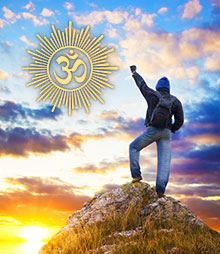 Why do we meditate? In this podcast Abbot George discusses the real reason to meditate as contrasted with wrong reasons. Then continuing with Patanjali’s instructions from the Yoga Sutras, he explains the obstacles to spiritual life and their effects.
Why do we meditate? In this podcast Abbot George discusses the real reason to meditate as contrasted with wrong reasons. Then continuing with Patanjali’s instructions from the Yoga Sutras, he explains the obstacles to spiritual life and their effects.
The obstacles Patanjali lists are as follows:
- Vyadhi: Disease of the body.
- Styana: Dullness; languor, debility; drooping state.
- Samshaya: Doubt; suspicion.
- Pramada: Carelessness; fault; guilt.
- Alasya: Laziness; idleness; apathy; sloth.
- Avirati: Hankering after objects; non-dispassion; sensual indulgence; lack of control; non-restraint.
- Bhranti-darshana: Delusion; erroneous view.
- Alabdhabhumikatva: Non-achievement of a stage; inability to find a footing.
- Anavashtitatvani: Unsteadiness; instability of mind; inability to find a footing; mental unsteadiness.
Patanjali lists these effects from the obstacles above:
- Dukha is pain; suffering; misery; sorrow; grief; unhappiness; stress; that which is unsatisfactory.
- Daurmanasya is despair, depression etc., caused by mental sickness; feeling of wretchedness and miserableness.
- Angamejayatva is shaking of the body; lack of control over the body.
- Shvasa-prashvasa is hard breathing; inspiration and expiration.
These are the symptoms of a mental state that is outward-turned and impelled toward–and absorbed in–externalities.
What is the means of removing these obstacles and their effects? Patanjali says in Sutra 32:
For removing these obstacles [there should be] the constant practice of the one principle [the japa and meditation of Om].
Listen to a full and practical explanation of these obstacles and overcoming them below (episode length 22:48):
Podcast: Play in new window | Download (Duration: 22:48 — 31.7MB)
Subscribe: Apple Podcasts | RSS
Click here to listen to Why We Meditate and the Obstacles We Overcome if you do not see the player above.
Read more on the Yoga Sutras of Patanjali.







